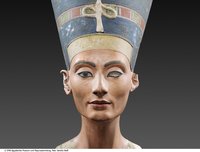Bei dem Ring handelt es sich um ein ganz besonderes Stück, da Karneol zu den bedeutendsten Halbedelsteinen zählte und aus Nubien importiert wurde. Die Ringplatte wird vom Thronnamen Echnatons geschmückt.
Nach: Mettlen, J., in: F. Seyfried (Hrsg.), Im Licht von Amarna. 100 Jahre Fund der Nofretete, Berlin 2012, S. 296 (Kat.-Nr. 79).
Angaben zur Herkunft:
Deutsche Orient-Gesellschaft (DOG), Auftraggeber
Borchardt, Ludwig (5.10.1863 - 12.8.1938), Grabungsleiter
Amenophis (Amenhotep) IV. / Echnaton
Datierung engl.: Amenhotep IV / Akhenaten
P 47.01 (Ägypten / Mittelägypten / Amarna / P 47 / P 47.01-03 (Anwesen))
Schenkung James Simon, 1920
en

